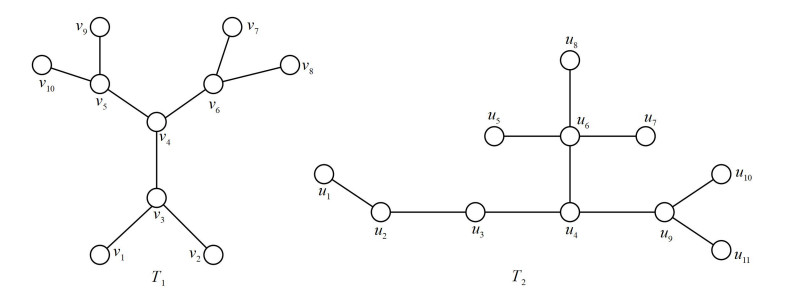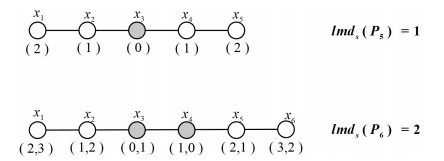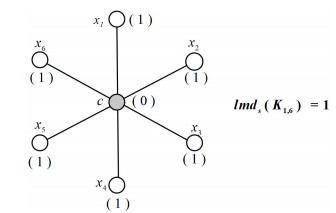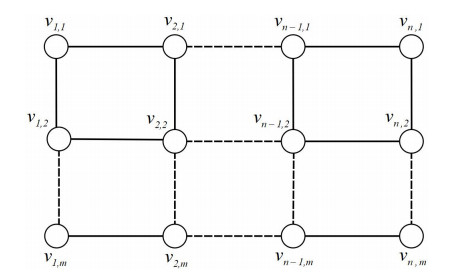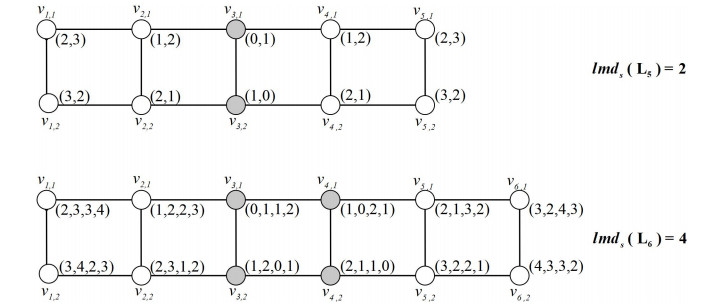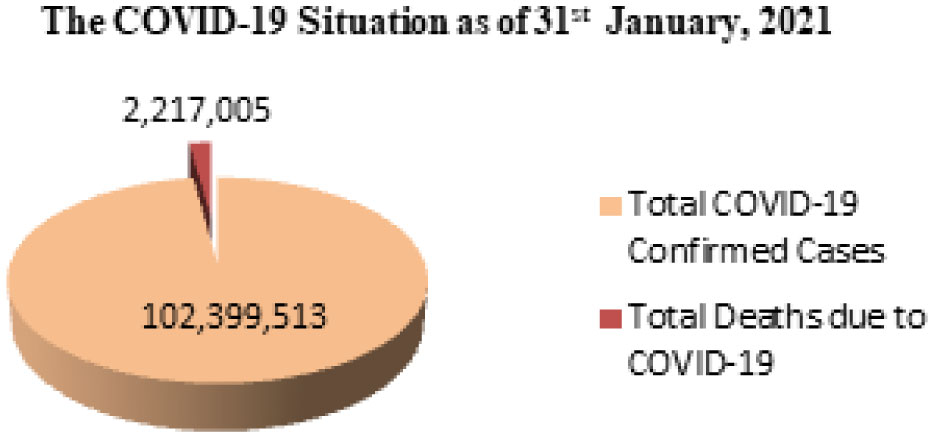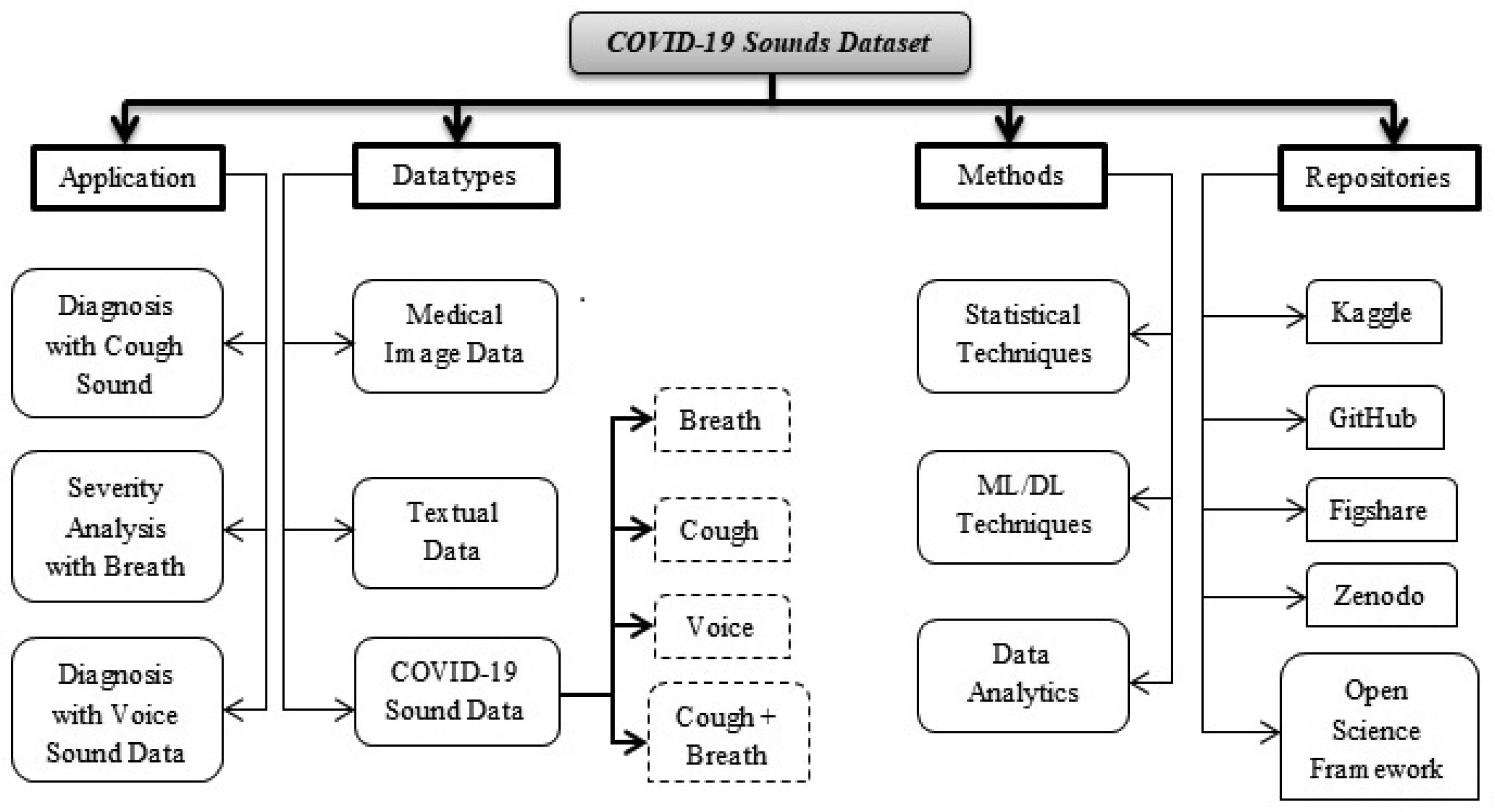1.
Introduction
Let G be a connected graph with vertex set V(G), edge set E(G) and |V(G)|=n. The distance d(u,v) in G of two vertices u and v is the length of the shortest u−v path in G. If there is no u−v path, then d(u,v)=∞ [1]. The eccentricity of a vertex v in G, denoted by e(v), is the distance between u and a vertex farthest from v in G, i.e., e(v)=max{d(u,v)|u∈V(G)} [2]. The radius of G, rad(G), is the smallest eccentricity among the vertices of G, while the largest eccentricity among the vertices of G is called the diameter of G, diam(G). The vertex u∈V(G) with e(u)=rad(G) is called a central vertex of G. For every nontrivial connected graph G, the radius and diameter are related by the inequality rad(G)≤diam(G)≤2rad(G) [2].
A vertex x is said to resolve vertices u and v of G if d(x,u)≠d(x,v). Let W={w1,w2,…,wk} be a subset of V(G) with k≤n. The representation of u∈V(G) with respect to W is an ordered set
The set W is a resolving set of G if and only if no two vertices of G have the same representation with respect to W. The metric dimension of G, denoted by dim(G), is the minimum cardinality over all resolving sets of G. In 1988, Slater introduced the concept of metric dimensions, which was motivated by the problem of uniquely recognizing an intruder's possible position, such as a fault in a computer network or a spoilt device [3]. The same concept of resolving set and metric dimension was introduced in 1976 by Harary and Melter [4] but using the terms locating sets and location numbers, respectively. However, several authors now have different definitions for these terms. This concept was later adopted by Chartrand et al. in 2000 [5] to find the upper and lower bounds of the metric dimensions of connected graphs and their properties. Since then, research related to metric dimensions has developed quite rapidly. Some of them were developed by combining the concept of metric dimension with other relevant concepts, such as complement metric dimension [6], fractional metric dimension [7], strong metric dimension [8], dominant metric dimension [9], mixed metric dimension [10] and edge metric dimension [11]. Then in 2020, Basak et al. developed the concept of metric dimension into fault-tolerant metric dimension applied to circulant graph C(n:1,2) [12]. Recently in 2023, Saha et al. developed the concept of fault-tolerant metric dimension by adding some parameters into optimal multi-level fault-tolerant resolving sets of circulant graph C(n:1,2) [13].
The concept of metric dimension involves minimizing the number of vertices on W for W⊆V(G), such that the distance of each vertex in W to any two vertices in G are different. This is similar to vertex coloring on graphs, where the number of colors needed to color vertices of a graph is minimized so that every two adjacent vertices get different colors. Using a related notion, Okamoto et al., in 2010 [14], developed the local metric dimension concept involving two adjacent vertices of G. Specifically, if two adjacent vertices of G have different metric W representations, then the set W is a local metric generator for G. Moreover, the minimum cardinality of the local metric set in graph G is called the local metric dimension and is denoted by lmd(G) [14]. For a non-trivial connected graph G, Okamoto et al., in 2010 [14] showed that since every two adjacent vertices have different representations in a local metric set, then
The local metric dimension has now been studied by several authors on different graph operations or in relation to other graph parameters, which include local fractional metric dimensions [15], local strong metric dimensions [16] and dominant local metric dimensions [17]. Susilowati et al. has studied the similarity of metric dimension and local metric dimension. It shows that diml(G)=dim(G)=n−1 if and only if G=Kn and diml(G)=dim(G) if and only if G=Kn [18]. The commutative characterization of graph operation with respect to metric dimension and local metric dimension has been presented in [19,20].
In this article, we introduce a new variant of the local metric dimension, called the central local metric dimension which combines the local metric set with all central vertices of G. The concept of local metric sets has applications in the analysis of chemical structural components [21]. Consider a scenario where one desires to identify certain sets of chemical compounds or atoms that are as central to other compounds as possible. This can be achieved by modeling with a connected graph and obtaining some information from the properties of the adjacency vertices on the chemical bound [14]. Moreover, the existence of central vertices in the central local metric ensemble should strengthen the implementation of the concept of local metric dimensions, not only in chemical structure but also in other domains.
The formal definition of the newly developed concept is formulated as the main result. Since the concept of metric dimensions is related to the distance between vertices in a graph, the central local metric dimension of a graph G is guaranteed to exist as long as G is connected. Some properties of the central local metric dimension and its consequences are discussed in the main result. We generalize in this paper the central local metric dimensions for acyclic graphs (trees) and grids. An acyclic graph is a graph that has no graph cycles and a connected acyclic graph is also known as a tree. One special tree considered in this paper is the path and star. We also use the obtained results for the path to generalize the results for grid (also known as the mesh) graphs. A grid graph, denoted as Pn×Pm, is an n×m lattice graph that results from the graph Cartesian product of paths Pn and Pm.
2.
Preliminary results
The following known results will be useful in the proof of the main results in this paper.
Theorem 2.1. [2] A graph G is a tree if and only if every two vertices of G are connected by a unique path.
Theorem 2.2. [22] Every tree has either one central vertex or two adjacent central vertices.
Theorem 2.3. [9] Let G be a connected graph. If W⊆V(G), then for every vi,vj∈W with i≠j, r(vi|W)≠r(vj|W).
Theorem 2.4. [14] Let G be a connected graph:
a) If G is a tree T, then lmd(T)=1.
b) If G is a path Pn, then lmd(Pn)=1.
c) For every two connected graphs G and H, lmd(G×H)=max{lmd(G),lmd(H)}.
d) If W is a subset of the vertex set of G containing a local metric set of G, then W is also a local metric set of G.
3.
Main result
In this section, we first introduce definitions of a central set, central local metric set, central local metric basis, and central local metric dimension.
Definition 3.1. Let G be a connected graph and S⊆V(G). S is called a central set of G if the element is all central vertex of G or S={s|e(s)=rad(G),s∈V(G)}.
Definition 3.2. Let W be an ordered set and W⊆V(G). W is called a central local metric set of G if W(G) is a local metric set and S⊆W. A minimal central local metric set of G is called a central local metric basis of G and its cardinality is called a central local metric dimension of G, denoted by lmds(G).
We also construct the upper and lower bound for the central local metric dimension on Theorem 3.1.
Theorem 3.1. Let G be a connected graph. If S is a central set of G and W is a local metric set of G, then:
Proof. Let G be a connected graph. S is a central set of G and W is a local metric set of G. By Definition 3.2, lmdS(G)≥|S| and lmdS(G)≥lmd(G) implying that lmds(G)≥max{|S|,lmd(G)}. Since the sets S and W are two sets that do not always intersect, S∪W is a local metric set by Theorem 2.4. Hence, S∪W is a central local metric set and V(G) is always a central local metric set. Consequently, lmds(G)≤min{|V(G)|,|S∪W|}. Then, max{|S|,lmd(G)}≤lmds(G)≤min{|V(G)|,|S∪W|}. □
Since the central local metric dimension contains a central set, the properties of the central set and central local metric dimension are described as follows.
Observation 3.1. The central set of a connected graph G is unique.
Lemma 3.1. Let S be a central set of a connected graph G, S=V(G) if and only if diam(G)=rad(G).
Proof. Let S=V(G) be a central set of G and suppose that diam(G)≠rad(G). Then there is a vertex u∈V(G) with e(u)≠rad(G) and u is not a central vertex of G or u∉S. This statement is contrary to S=V(G). Conversely, let diam(G)=rad(G) and suppose that S≠V(G). Then, there is a vertex u∈V(G) where u is not a central vertex of G or u∉S, so e(u)≠rad(G). This statement is contrary to diam(G)=rad(G). □
Lemma 3.2. Let S be a central set of a connected graph G. If S=V(G), then S is a central local metric set of G.
Proof. Let S be a central set of G and S=V(G). Take any two adjacent vertices u,v∈V(G), since S=V(G), then u and v also in S. Based on theorem 2.3, implies that r(u|S)≠r(v|S) for all u,v∈V(G). So, S is a central local metric set of G. □
Theorem 3.2. Let G be a connected graph and |V(G)|=n, the central local metric dimension lmds(G)=n if and only if diam(G)=rad(G).
Proof. Let G be a connected graph with |V(G)|=n and lmds(G)=n. Suppose that diam(G)≠rad(G) then based on Lemma 3.1, S≠V(G). Let S={x1,x2,...,xn−1}. Then for every two adjacent vertices xn∈V(G) and xi∈S implies r(xn|S)≠r(xi|S). So, S is a central local metric set, and this statement is a contradiction with lmds(G)=n. Conversely, let G with V(G)=n and diam(G)=rad(G), based on Lemma 3.1 the central set of G is S=V(G) and based on Lemma 3.2, S is a central local metric set of G, then lmds(G)=|V(G)|=n. □
The graph Kn, n≥3, is a complete graph with vertex set {1,2,...,n} [23]. Every vertex in Kn is adjacent to every other vertex of V(Kn), then diam(Kn)=rad(Kn). A similar reason is applied to a complete bipartite graph Km,n, m,n≥2 and diam(Km,n)=rad(Km,n). So, the Corollaries 1 and 2 are the consequences of Theorem 3.2.
Corollary 3.1. Let G be a complete graph Kn, where n≥3. Then lmdS(G)=n.
Corollary 3.2. Let G be a complete bipartite graph Km,n, where m,n≥2. Then lmdS(G)=m+n.
The graph Cn, where n≥3, is a cycle with V(Cn)={xi|1≤i≤n} and E(Cn)={vivi+1|1≤i≤n−1}∪{vnv1}. It is easy to say that each vertex on Cn has the same distance to the farthest vertex. So, e(v1)=e(v2)=e(v2)=...=e(vn)=⌊n2⌋. Then, diam(Cn)=rad(Cn). Based on Theorem 3.2 we have a Corollary 3.3.
Corollary 3.3. Let G be a cycle graph Cn, where n≥3. Then lmdS(G)=n.
The generalized wheel graph Wm,n when m>1 and n>3 is also a graph with diam(G)=rad(G), then the Corollary 3.4 also a consequent from Theorem 3.2.
Corollary 3.4. Let G be a generalized wheel graph Wm,n, where m>1 and n>3. Then lmdS(G)=m+n.
Let graph Wm,3 be a generalized wheel graph Wm,n for m>1 and n=3 with V(Wm,3)={ci|1≤i≤m}∪{xj|1≤j≤3} and E(Wm,3)={cixj|1≤i≤m,1≤j≤3}∪{xjxj+1|1≤j≤2}∪{x3x1}. The vertex ci adjacent with xj, while the vertex x1, x2 and x3 adjacent each other. Then, the diameter of Wm,3 for m>1 is not equal to the radius. Lemma 3.3 describe the central set of Wm,3 and it follow by Theorem 3.3.
Lemma 3.3. Let S be a central set of generalized wheel graph Wm,3 for m>1. Then S={x1,x2,x3}.
Proof. Let S be a central set of Wm,3 for m>1. The vertex ci, for 1≤i≤m, adjacent with x1, x2, and x3, while the vertex x1, x2 and x3 adjacent each other. Then, the eccentricity of each vertex on Wm,3 is e(c1)=e(c2)=...=e(cm)=2 and e(x1)=e(x2)=e(x3)=1. Consequently, rad(Wm,3)=1 and diam(Wm,3)=2. Since e(x1)=e(x2)=e(x3)=1=rad(Wm,3), then x1, x2 and x3 are the central vertices of Wm,3. So, the central set of Wm,3 is S={x1,x2,x3} for m>1. □
Theorem 3.3. Let G be a generalized wheel graph Wm,3 for m>1. Then lmds(G)=3.
Proof. Let S be a central set of Wm,3 for m>1. Then, based on Lemma 3.3 we get S={x1,x2,x3} and |S|=3. Since the vertex ci adjacent with xj, where xj∈S, then r(ci|S)≠r(xj|S), for 1≤i≤m and 1≤j≤3. Furthermore, the vertex x1, x2 and x3 adjacent each other, where S={x1,x2,x3}, then by Theorem 2.3, r(xj|S)≠r(xj+1|S) and r(x3|S)≠r(x1|S). Consequently, S is a central local metric set with minimum cardinality. So, lmds(Wm,3)=3. □
Figure 1 is an example of the central local metric dimension on W3,3. Based on Lemma 3.3, the central local metric set of W3,3 is S={x1,x2,x3}. Then, r(x1|S)=(0,1,1), r(x2|S)=(1,0,1), r(x1|S)=(1,1,0) and r(c1|S)=(c2|S)=(c3|S)=(1,1,1) where c1, c2 and c3 are not adjacent each other. It is easy to see that S is a central local metric set of W3,3 and lmds(W3,3)=3.
Furthermore, we obtain the central local metric dimension of trees. Let T be a tree. By Theorem 2.2, T has either only one central vertex or two adjacent central vertices. Figure 2 shows examples T1 and T2 of T with one and two adjacent central vertices, respectively.
Given T1 in Figure 2. The eccentricity of each vertices in T1 are e(v1)=4,e(v2)=4,e(v3)=3,e(v4)=2,e(v5)=3,e(v6)=3,e(v7)=4,e(v8)=4,e(v9)=4 and e(v10)=4. So diam(T1)=4 and rad(T1)=2 where e(v4)=2, implying that v4 is a central vertex of T1. In this case, one of the longest paths in T1 is v2−v3−v4−v6−v7 with length 4 which contains the central vertices v4.
Similarly, T2 in Figure 2 has a central vertex on the longest path of T2. The eccentricity of each vertices in T2 are e(u1)=5, e(u2)=4, e(u3)=3, e(u4)=3, e(u5)=5, e(u6)=4, e(u7)=5, e(u8)=5, e(u9)=4, e(u10)=5 and e(u11)=5. So, diam(T2)=5 and rad(T2)=3 with e(u3)=3 and e(u4)=3. Then u3 and u4 are the central vertices of T2. In this case, one of the longest paths in T2 is u1−u2−u3−u4−u9−u10 with length 5, on which lies the central vertices u3 and u4.
From the illustrations above, it is easy to see that a central vertex of a tree T lies on the longest path of T whose start and end points are also endpoints in T. By using Theorem 2.2, we prove Lemma 3.4 which describes the position of a central vertex in a tree.
Lemma 3.4. Let T be a tree. Let u0,u1,…,uk be a longest path in T with diam(T)=k. Then the central set S of T is:
Proof. Let T be a tree with diam(T)=k. Take any path in T whose length is k, say, for example u0,u1,…,uk. Since u0 and uk are end vertices of this path, e(u0)=e(uk)=k. Vertices u1 and uk−1 are the second vertices after the end vertices u0 and uk respectively. So, e(u1)=e(uk−1)=k−1. Similarly, e(u2)=e(uk−2)=k−2, and so on. Since diam(T)=k, the iteration stop on the vertex uk2 with e(uk2)=k2 for k even. So, rad(T)=k2. However for k odd, the iteration stop on vertices u⌊k2⌋ and u⌊k2+1⌋ with e(u⌊k2⌋)=e(u⌊k2+1⌋)=⌈k2⌉. So that rad(T)=⌈k2⌉. Therefore, the central vertices of T with diam(T)=k for k even is uk2 and for k odd are u⌊k2⌋ and u⌈k2+1⌉. Hence, the central set S of T with diam(T)=k, for k even is S={uk2} and for k odd is S={u⌊k2⌋,u⌊k2+1⌋}. □
The following Theorem 3.4 is formulated to determine the central local metric dimension of T.
Theorem 3.4. Let T be a tree with diam(T)=k. The central local metric dimension, lmds(T) of T is given by
Proof.Suppose T is a tree satisfying diam(T)=k, and u0,u1,…,uk is a longest path in T. We consider two cases.
Case 1: k is even. By Lemma 3.4, the central set of T is S={uk2}, and |S|=1. It is known from Theorem 2.4 that lmd(T)=1 and from Theorem 3.1 that lmds(T)≥1. Let W=S={uk2}. By Theorem 2.1, if any two adjacent vertices u and v on T are taken, there is a unique path between vertex u and vertex v to the central vertex uk2. Thus, it is easy to see that for the path u,v,…,uk2, d(u,uk2)≠d(v,uk2). Consequently, r(u|W)≠r(v|W), for ∀u,v∈V(T) where uv∈E(T). Thus, S is a local metric set as well as a central set. So, S={uk2} is a central local metric set with minimum cardinality. Hence, lmds(T)=1 for T with diam(T)=k and k even.
Case 2: k is odd. By Lemma 3.4, the central set of T is S={u⌊k2⌋,u⌊k2+1⌋}, and |S|=2. It is known from Theorem 2.4 that lmd(T)=1 and from Theorem 3.1 that lmds(T)≥max{|S|,lmd(T)}=max{1,2}=2, then lmds(T)≥2. Take W=S={u⌊k2⌋,u⌊k2+1⌋}. By Theorem 2.1, if any two adjacent vertices u and v on T are taken, there is a unique path between vertex u and vertex v to the central vertices u⌊k2⌋ and u⌊k2+1⌋. For the path u,v,…,u⌊k2⌋,u⌊k2+1⌋, it is easy to see that d(u,u⌊k2⌋)≠d(v,u⌊k2⌋) and d(u,u⌊k2+1⌋)≠d(v,u⌊k2+1⌋). Thus, r(u|W)≠r(v|W) for ∀u,v∈V(T) where uv∈E(T). So, S is a local metric set as well as a central set. Therefore, S={u⌊k2⌋,u⌊k2+1⌋} is a central local metric set with minimum cardinality. Then, lmds(T)=2 for T with diam(T)=k and k odd. □
Refer to Figure 2. The central local metric dimension of T1 and T2 based on Theorem 3.4 are lmds(T1)=1 and lmds(T2)=2, respectively.
The Path Pn is a graph of order n and size n−1. Let the vertex of Pn labeled by xi, for 1≤i≤n and the edge labeled by xixi+1, for 1≤i≤n−1. The diameter of Pn is diam(Pn)=n−1. Then, the central vertex of Pn when n odd is x⌈n2⌉ and the central vertices of Pn when n even are x⌈n2⌉ and x⌈n2+1⌉. Since Pn is one example of a tree, based on Theorem 3.4 we have two cases for the central local metric dimension of Pn as Corollary 3.5.
Corollary 3.5. If G is a path graph Pn, then lmds(G)=1 for n odd and lmds(G)=2 for n even.
Figure 3 is an example of the local metric dimension of path Pn, for n=5 and n=6. The vertex set of P5 is V(P5)={x1,x2,x3,x4,x5} and the edge set is E(P5)={xixi+1|1≤i≤n−1}. Since diam(P5)=4, the central vertex is x3 and the central set is S={x3}. Let W=S. Then, we have r(x1|W)=(2), r(x2|W)=(1), r(x3|W)=(0), r(x4|W)=(1), and r(x5|W)=(2). It is easy to see that r(xi|W)≠r(xi+1|W) for every two adjacent vertices xi and xi+1 in P5, 1≤i≤n−1. Then, W is a central local metric set with minimum cardinality and lmds(P5)=1. This result is consistent with Corollary 3.5. Similarly, the vertex set of P6 is V(P6)={x1,x2,x3,x4,x5,x6} and diam(P6)=5. The central Corollary 3.5, lmds(P6)=2.
The star K1,n is a graph with one central vertex and n leaves. Let the central vertex of K1,n labeled by c and the other vertex be labeled by xi, for 1≤i≤n. The diameter of K1,n, for n≥2, is diam(K1,n)=2. Since K1,n is also one example of a tree, then Corollary 3.6 is a direct consequence of Theorem 3.4.
Corollary 3.6. If G is a star graph K1,n, for n≥2, then lmds(G)=1.
Figure 4 is an example the local metric dimension of K1,n, for n=6. The vertex set of K1,6 is V(K1,6)={c,x1,x2,x3,x4,x5,x6} and the edge set is E(K1,6)={cxi|1≤i≤6}. Since the diam(K1,6)=2, the central vertex of K1,6 is c and the central set is S={c}. Let W=S, then we have r(c|W)=(0) and r(x1|W)=r(x2|W)=...=r(x6|W)=(1) where x1,x2,...,x6 are not adjacent each other. It is easy to see that r(c|W)≠r(xi|W) for every two adjacent vertices c and xi in K1,6, 1≤i≤n. Then W is a central local metric set with minimum cardinality and lmds(K1,6)=1. This result is also consistent with Corollary 3.6.
The grid graph, denoted by Pn×Pm, is the graph cartesian product of path graphs Pn and Pm. It has order nm and size (n−1)m+n. The vertex set and edge set of Pn×Pm are, respectively V(G)={vi,j|1≤i≤nand1≤j≤m} and E(G)={vi,jvi+1,j|1≤i≤n−1and1≤j≤m}∪{vi,jvi,j+1|1≤i≤nand1≤j≤m−1}. Figure 5 is an illustration of a grid graph Pn×Pm. It is clear from Figure 5 that every two adjacent vertices on Pn×Pm are not adjacent to the same vertex. To simplify the process of proving the following theorem, this condition is formulated as Observation 3.2 as follows.
Observation 3.2. There are no two adjacent vertices of Pn×Pm adjacent with the same vertex.
We know that the diameter of Pn is n−1 and the diameter of Pm is m−1. So, we get Observation 3.3 as follows.
Observation 3.3. The diameter of Pn×Pm is n+m−2.
Based on Theorem 2.4, lmd(Pn)=1 and lmd(G×H)=max{lmd(G),lmd(H)} for every two connected graph G and H. Then, we get lmd(Pn×Pm)=max{lmd(Pn),lmd(Pm)} and the Observation 3.4 holds for it.
Observation 3.4. Let G=Pn×Pm. Then lmd(G)=1.
We use these observations in the proof of the following lemma and theorem.
Lemma 3.5. Let S be a central set of Pn×Pm. Then:
Proof. Let S be a central set of Pn×Pm, S1 be a central set of Pn and S2 be a central set of Pm. Since diam(Pn)=n−1, based on Lemma 3.4 we get S1={v⌈n2⌉} for n odd and S1={v⌈n2⌉,v⌈n2+1⌉} for n even. The same applies for Pm because diam(Pn)=n−1, then S2={v⌈m2⌉} for m odd and S2={v⌈m2⌉,v⌈m2+1⌉} for m even. Moreover, we consider the following cases since the grid graph is a graph resulting from the Cartesian product of two path graphs, say Pn×Pm.
Case 1: n,m are odd. Since S1={v⌈n2⌉} and S2={v⌈m2⌉}. Vertex v⌈n2⌉,⌈m2⌉ is a central vertex of Pn×Pm. In line with this, by Observation 3.3, diam(Pn×Pm)=n+m−2 with e(v1,1)=e(vn,1)=e(v1,m)=e(vn,m)=n+m−2. The radius of Pn×Pm is rad(Pn×Pm)=⌈n2⌉ with e(v⌈n2⌉,⌈m2⌉)=⌈n2⌉. So, the central set of Pn×Pm is S={v⌈n2⌉,⌈m2⌉}, for n,m odd.
Case 2: n is even and m is odd. Since n is even and m is odd, S1={v⌈n2⌉,v⌈n2+1⌉} and S2={v⌈m2⌉}. It is apparent from Observation 3.3 that diam(Pn×Pm)=n+m−2 with e(v1,1)=e(vn,1)=e(v1,m)=e(vn,m)=n+m−2 and rad(Pn×Pm)=⌈n2+1⌉ with e(v⌈n2⌉,⌈m2⌉)=e(v⌈n2+1⌉,⌈m2⌉)=⌈n2+1⌉. Thus, the central set of Pn×Pm is S={v⌈n2⌉,⌈m2⌉,v⌈n2+1⌉,⌈m2⌉}, for n even and m odd.
Case 3: n is odd and m is even. Since n is odd and m is even, S1={v⌈n2⌉} and S2={v⌈m2⌉,v⌈m2+1⌉}. Similar to Case 2, we consider from Observation 3.3 that, diam(Pn×Pm)=n+m−2. The radius of Pn×Pm is rad(Pn×Pm)=⌈n2+1⌉ with e(v⌈n2⌉,⌈m2⌉)=e(v⌈n2⌉,⌈m2+1⌉)=⌈n2+1⌉. So, the central set of Pn×Pm for n odd and m even is S={v⌈n2⌉,⌈m2⌉,v⌈n2⌉,⌈m2+1⌉}.
Case 4: n,m are even. Since S1={v⌈n2⌉,v⌈n2+1⌉} and S2={v⌈m2⌉,v⌈m2+1⌉}. The central vertices of Pn×Pm are v⌈n2⌉,⌈m2⌉, v⌈n2+1⌉,⌈m2⌉, v⌈n2⌉,⌈m2+1⌉, and v⌈n2+1⌉,⌈m2+1⌉. In line with this, based on Observation 3.3, diam(Pn×Pm)=n+m−2 and the radius of Pn×Pm is rad(Pn×Pm)=⌈n2+2⌉ with e(v⌈n2⌉,⌈m2⌉)=e(v⌈n2+1⌉,⌈m2⌉)=e(v⌈n2⌉,⌈m2+1⌉)=e(v⌈n2+1⌉,⌈m2+1⌉)=⌈n2+2⌉. So, the central set of Pn×Pm is S={v⌈n2⌉,⌈m2⌉,v⌈n2+1⌉,⌈m2⌉,v⌈n2⌉,⌈m2+1⌉,v⌈n2+1⌉,⌈m2+1⌉} for n even and m even. □
Recall that by Theorem 2.4, lmd(Pn)=lmd(Pm)=1 in conjunction with Observation 3.4 yields lmd(Pn×Pm)=1. We prove the following theorem for the central local metric dimension on Pn×Pm.
Theorem 3.5. Let G be the grid graph Pn×Pm.
Then,
Proof. Let S be a central set of the grid graph Pn×Pm. We prove the equality for different cases below.
Case 1: n,m are odd. Based on Lemma 3.5 we get S={v⌈n2⌉,⌈m2⌉} and |S|=1. Since lmd(Pn×Pm)=1 by Observation 3.4, using Theorem 3.1 we have lmds(Pn×Pm)≥1. The vertex vi,j is adjacent to vi+1,j for every vi,j,vi+1,j∈V(Pn×Pm), where 1≤i≤n−1 and 1≤j≤m. By Observation 3.2, there is a path in Pn×Pm which contains vertices vi,j, vi+1,j, and the central vertex v⌈n2⌉,⌈m2⌉ such that d(vi,j,v⌈n2⌉,⌈m2⌉)≠d(vi+1,j,v⌈n2⌉,⌈m2⌉). Consequently, r(vi,j|S)≠r(vi+1,j|S). Similarly, the vertex vi,j is adjacent to vi,j+1 for every vi,j,vi,j+1∈V(G), where 1≤i≤n and 1≤j≤m−1. So, d(vi,j,v⌈n2⌉,⌈m2⌉)≠d(vi,j+1,v⌈n2⌉,⌈m2⌉) and r(vi,j|S)≠r(vi,j+1|S). Thus, S is a central local metric set of Pn×Pm and lmds(Pn×Pm)=1, for n,m odd.
Case 2: either n or m is odd. Let S1 be the central set of Pn×Pm when n even and m odd and S2 be the central set Pn×Pm when n odd and m even. Then, based on Lemma 3.5, S1={v⌈n2⌉,⌈m2⌉,v⌈n2+1⌉,⌈m2⌉} and S2={v⌈n2⌉,⌈m2⌉,v⌈n2⌉,⌈m2+1⌉} where |S1|=|S2|=2. Without loss of generality, suppose n is even and m is odd. Then, by Observation 3.4, lmd(Pn×Pm)=1, in conjunction with Theorem 3.1 yields lmds(Pn×Pm)≥2. The vertex vi,j is adjacent to vi+1,j, for every vi,j,vi+1,j∈V(Pn×Pm) where 1≤i≤n−1 and 1≤j≤m. Therefore Observation 3.2 shows that there is a path in Pn×Pm which contains vertices vi,j, vi+1,j, and the central vertices v⌈n2⌉,⌈m2⌉ and v⌈n2+1⌉,⌈m2⌉ such that d(vi,j,v⌈n2⌉,⌈m2⌉)≠d(vi+1,j,v⌈n2⌉,⌈m2⌉) and d(vi,j,v⌈n2+1⌉,⌈m2⌉)≠d(vi+1,j,v⌈n2+1⌉,⌈m2⌉). Consequently, r(vi,j|S1)≠r(vi+1,j|S1). Correspondingly, the vertex vi,j is also adjacent to vi,j+1 for every vi,j,vi,j+1∈V(Pn×Pm), where 1≤i≤n and 1≤j≤m−1 such that d(vi,j,v⌈n2⌉,⌈m2⌉)≠d(vi,j+1,v⌈n2⌉,⌈m2⌉) and d(vi,j,v⌈n2+1⌉,⌈m2⌉)≠d(vi,j+1,v⌈n2+1⌉,⌈m2⌉). This then leads to the fact that r(vi,j|S1)≠r(vi,j+1|S1). Thus, S1={v⌈n2⌉,⌈m2⌉,v⌈n2+1⌉,⌈m2⌉} is a central local metric set of Pn×Pm for n even and m odd. In the same way, it can be proven that S2={v⌈n2⌉,⌈m2⌉,v⌈n2⌉,⌈m2+1⌉} is a central local metric set of Pn×Pm for n odd and m even. Hence, lmds(Pn×Pm)=2, for either n or m is odd.
Case 3: n,m are even. Based on Lemma 3.5 we get S={v⌈n2⌉,⌈m2⌉,v⌈n2+1⌉,⌈m2⌉,v⌈n2⌉,⌈m2+1⌉,v⌈n2+1⌉,⌈m2+1⌉} and |S|=4. Since by Observation 3.4, lmd(Pn×Pm)=1, then in conjunction with Theorem 3.1 yields that lmds(Pn×Pm)≥4. The vertex vi,j is adjacent to vi+1,j, for every vi,j,vi+1,j∈V(Pn×Pm), where 1≤i≤n−1 and 1≤j≤m. Based on Observation 3.2, a path in Pn×Pm contains vertex vi,j, vertex vi+1,j, and all central vertices on Pn×Pm. So, d(vi,j,v⌈n2⌉,⌈m2⌉)≠d(vi+1,j,v⌈n2⌉,⌈m2⌉); d(vi,j,v⌈n2+1⌉,⌈m2⌉)≠d(vi+1,j,v⌈n2+1⌉,⌈m2⌉); d(vi,j,v⌈n2⌉,⌈m2+1⌉)≠d(vi+1,j,v⌈n2⌉,⌈m2+1⌉); and d(vi,j,v⌈n2+1⌉,⌈m2+1⌉)≠d(vi+1,j,v⌈n2+1⌉,⌈m2+1⌉), implying that r(vi,j|S)≠r(vi+1,j|S). Similar argument applied to the vertex vi,j which is adjacent to vi,j+1, for every vi,j,vi,j+1∈V(Pn×Pm), where 1≤i≤n and 1≤j≤m−1, yields d(vi,j,v⌈n2⌉,⌈m2⌉)≠d(vi,j+1,v⌈n2⌉,⌈m2⌉); d(vi,j,v⌈n2+1⌉,⌈m2⌉)≠d(vi,j+1,v⌈n2+1⌉,⌈m2⌉); d(vi,j,v⌈n2⌉,⌈m2+1⌉)≠d(vi,j+1,v⌈n2⌉,⌈m2+1⌉); and d(vi,j,v⌈n2+1⌉,⌈m2+1⌉)≠d(vi,j+1,v⌈n2+1⌉,⌈m2+1⌉. Consequently, r(vi,j|S)≠r(vi,j+1|S). Thus, S is a central local metric set of Pn×Pm and lmds(Pn×Pm)=4, for n,m even. □
The ladder graph, denoted as Ln, is a planar graph with 2n vertices and 3n−2 edges, obtained from the cartesian product of the path graphs Pn and P2. Thus, it is a special case of the grid graph, Pn×Pm with m=2. Corollary 3.7 is a consequence of Theorem 3.5.
Corollary 3.7. Let G be a ladder graph, Ln=Pn×P2. The central local metric dimension of Ln is given as
Figure 6 is an example of the local metric dimension of ladder Ln, for n=5 and n=6. The vertex set and edge set of L5 are, respectively V(G)={vi,j|1≤i≤5andj=1,2} and E(G)={vi,jvi+1,j|1≤i≤4andj=1,2}∪{vi,jvi,j+1|1≤i≤5andj=1}. Based on Lemma 3.5, the central set of L5 is S={v3,1,v3,2}. Let W=S. Then, we have r(v1,1|W)=(2,3), r(v2,1|W)=(1,2), r(v3,1|W)=(0,1), r(v4,1|W)=(1,2), r(v5,1|W)=(2,3), r(v1,2|W)=(3,2), r(v2,2|W)=(2,1), r(v3,2|W)=(1,0), r(v4,2|W)=(2,1), and r(v5,2|W)=(3,2). It is easy to see that r(vi,j|W)≠r(vi+1,j|W) for every two adjacent vertices vi,j and vi+1,j and r(vi,j|W)≠r(vi,j+1|W) for every two adjacent vertices vi,j and vi,j+1. Then, W is a central local metric set with minimum cardinality and lmds(L5)=2. This result is consistent with Corollary 3.7. Similarly, based on Lemma 3.5, the central set of L6 is S={v3,1,v4,1,v3,2,v4,2}. Then, based on Corollary 3.7, lmds(P6)=4.
4.
Conclusions
This article defined a new concept, namely, the central local metric dimension of a graph. The central local metric dimension is the minimum cardinality of a local metric set that contains the central set in a graph. Thus, the lower bound of the central local metric dimension refers to the local metric dimension and the cardinality of the central set. Some properties of the central local metric dimension are presented to support future research. We get the exact values for the central local metric set of some particular classes of graphs such as cycle, complete graph, complete bipartite graph, generalized wheel graph, trees, and cartesian product of two paths. Since the central local metric dimension is a new concept, there are still many open problems for further exploration, especially in other classes of graphs.
Use of AI tools declaration
We declare that we have not used Artificial Intelligence (AI) tools in the creation of this article.
Acknowledgments
The publication of this paper is funded by Center for Higher Education Fund (Balai Pembiayaan Pendidikan Tinggi), Center of Education Services (Pusat Layanan Pendidikan), and Education Fund Management Institution (LPDP), Ministry of Education, Culture, Research, and Technology of the Republic of Indonesia.
Conflict of interest
There is no conflict of interest in this research.










 DownLoad:
DownLoad:
